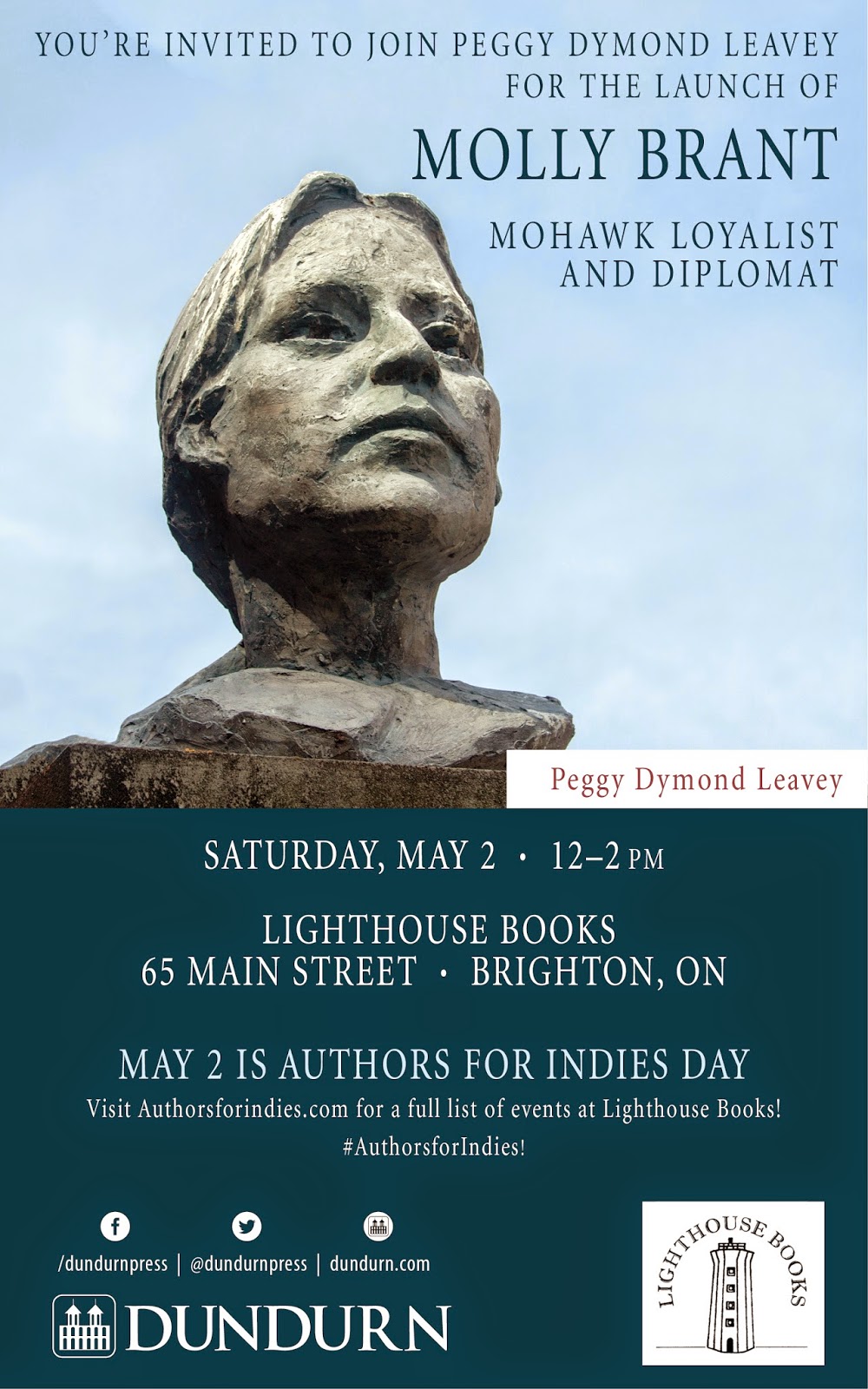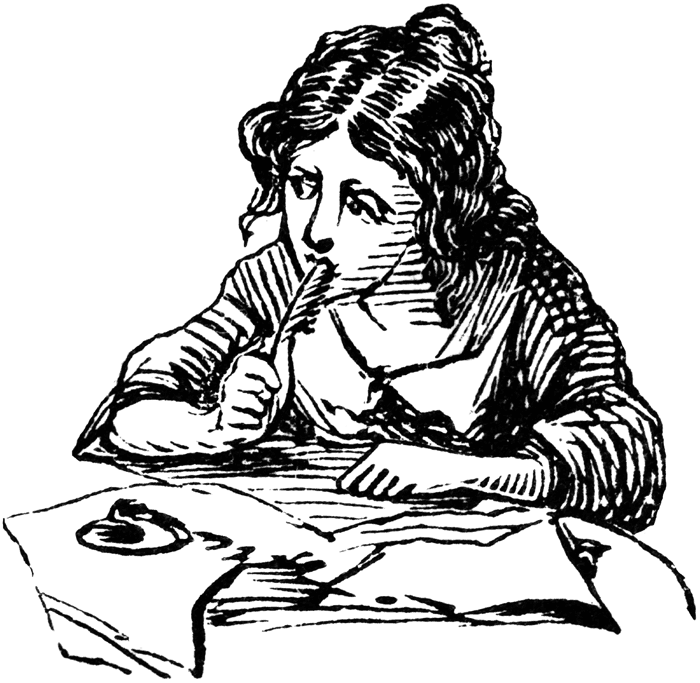new posts in all blogs
Viewing Blog: Peggy Dymond Leavey- children's writer, Most Recent at Top
Results 1 - 25 of 235
Thoughts on my writing life.
www.peggydymondleavey.com
Statistics for Peggy Dymond Leavey- children's writer
Number of Readers that added this blog to their MyJacketFlap: 2
 |
| The old covered bridge, built in 1833, was becoming dilapidated in this 1910 photo. |
Years ago when I was trying to take my writing "hobby" (personally, I never thought of it as that) to the next level, I began to write a number of articles for the local newspaper. I'd already had an article published in the Ontario Churchman, a piece about a local centenarian I'd interviewed. Hers was a fascinating story about teaching school in the early 1900s. I wondered if there might be a market for more of these personal interest stories.
This was our history and, as it turned out, the local paper took every article I could write. They named the series Quinte Living History. During an interview with a lifelong resident of the town, she described her fear of crossing the covered bridge over the river at night; she also told of the vast Gilmour Lumber Company that used to dominate the scene at the river's mouth, the shops and homes that once lined the main street.
Because I've always dreaded "cold calling" anyone to ask if they'd agree to an interview, I started out by contacting people I already knew — people from my church, friends of my parents. Fortunately, after the interview several offered suggestions of other folk who had led interesting lives, a local doctor who still made house calls, a Great Lakes sailor, a family who managed one of the first movie houses in town, a Barnardo "child", a larger-than-life, retired police chief who was also a champion pie eater.
The newspaper was published twice a week in those days before personal computers. Before long, my name became recognized as a writer and someone who was interested in local history. That meant that I was asked to join others who were working on story collections about Trenton and the wider area, and I became a contributor and co-editor for three books of local history. It proved to be a good place to start.
Happy New Year! Happy Writing!
I recently wrote a review of the new edition of Canadian writer Mazo de la Roche's autobiography for the publisher, Dundurn Press. They ran it on their blog earlier this month.
I first started reading de la Roche's Jalna series after taking The Whiteoaks of Jalna in Grade 10 English Lit. class. I was hooked!
The new edition of Mazo de la Roche's autobiography, Ringing the Changes, is enhanced by Heather Kirk's well-documented introduction. It answers a number of questions and provides dates for many events; de la Roche told the things she thought important.
Her autobiography might have been easier to write, the author contends, if her forebears had been other than “distinguished-looking nobodies.” This is typical of her ability to laugh at herself; her sense of humour is evident throughout. Written by a novelist, the book is filled with intriguing characters and dramatic scenes.
The story begins with the arrival of Mazo's young cousin, Caroline Clement, as part of the household in Newmarket, Ontario. The two little girls become lifelong companions.
Both children are artistically inclined; Caroline plays several musical instruments, and Mazo says she herself was born to write. She tells of an idyllic childhood. Her father, though often absent from home, was a reader, a dog-lover, sensitive yet enthusiastic, a man who doted on his young daughter. Her vivid description of her agony over his death is heartrending.
Mazo, “an eternal sketcher”, attended the Ontario School for Art for a time and took some lectures at university. She wrote her first successful story longhand and in pencil. It was accepted by Munsey's Magazine and Mazo was paid $50.
As well as having her own job, Caroline was Mazo's secretary, taking dictation, making travel arrangements for their many trips abroad, and often going house-hunting for the pair.
Throughout her life Mazo de la Roche suffered from “illness of the nerves”, sometimes losing her ability to write. She insisted on seclusion, and at the end of WWI had a cottage built in the woods. At Trail Cottage she was inspired to write Jalna, the book that won her the prestigious Atlantic Monthly prize.
Ill health continued to plague her. Once they were better off financially, Caroline was able to quit work and stay home with Mazo. She found joy in writing again, especially the stories of the Whiteoak family of Jalna.
She and Caroline travelled extensively, falling in love with the English countryside and renting houses in Devon and Cornwall. But they always found themselves longing for Canada. In 1931 Mazo adopted a little girl and a baby boy, and together they returned to Devon. Mazo enjoyed visits to London and meeting other writers. Eventually, they took a house just around the corner from Buckingham Palace. Still, Canada beckoned.
They returned to Erindale, a few miles from Trail Cottage. When they heard that de la Roche's bookWhiteoaks was to be produced as a play in London, they went back to England again. RKO made her novel Jalna into a Hollywood movie.
De la Roche was an indulgent parent, providing her two children with nannies and governesses. The household included a cook, a parlour maid, a gardener, and a chauffeur.
In 1938 in Toronto, she received the Lorne Pierce Medal, presented by the Royal Society of Canada for distinguished service to Canadian Literature.
After surgery to remove a cyst from her throat she returned to Vale House to recuperate. But the threat of war and the fact that they lived dangerously close to London made them return to Canada and a house near the village of Thornhill. There, in 1939 de la Roche finished her autobiography, saying she had no urge to write about life after the war. One wishes that she had.
Mazo de la Roche was seventy-five at the time. Over her lifetime she wrote a total of thirty-seven books, sixteen in the beloved Whiteoak family saga. She and Caroline lived in the Thornhill house for many years. Mazo de la Roche died in 1961.
Could Molly Brant Be Related to Pauline Johnson?
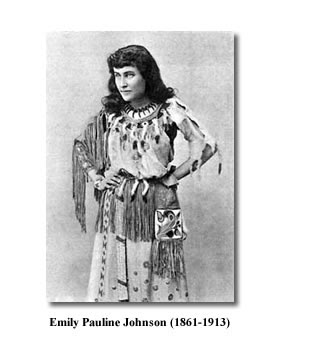
During the Q & A session at a recent presentation on Molly Brant: Mohawk Loyalist and Diplomat, someone in the audience asked if Molly Brant was related to the native poet, Pauline Johnson.
It's a logical question. Both women were of Mohawk blood, and Molly's eight children were all Johnsons. It seemed to beg some further research.
Although the two women lived in different centuries, it turns out they both had roots in the Mohawk Valley in central New York state, the traditional homeland of their people.
Emily Pauline Johnson was born in 1861 on Six Nations territory on the Grand River in Ontario. Her father was a Mohawk of the Wolf clan, the same as Molly Brant. Pauline's mother, however, was English, and the girl was raised in a middle-class family, one where an aloof attitude was fostered, along with elegant manners.
Pauline was proud of her Mohawk heritage and took for herself the name of her paternal great-grandfather Tekahionwake.
Tekahionwake was born in 1758 (confidentially, the year before Molly Brant moved in with William Johnson) in the colony of New York. At the Mohawk youth's baptism, Sir William Johnson, Superintendent of Indian Affairs for the northern colonies, acted as his godfather. Subsequently, Tekahionwake took as his name "Jacob Johnson", and Johnson became the family's surname down through the generations.
So, E. Pauline Johnson was no relation to Brown Lady Johnson, as Molly during her years as chatelaine at Johnson Hall was respectfully dubbed.
Pauline, the Canadian poet, found it difficult during the late nineteenth century, to make a living from her writing, but she became a skilled orator, delivering dramatic recitations of her poems as she toured Canada and the United States. She died of breast cancer in 1913.
By:
Peggy Dymond Leavey,
on 8/26/2015
Blog:
Peggy Dymond Leavey- children's writer
(
Login to Add to MyJacketFlap)
JacketFlap tags:
Molly Brant Mohawk Loyalist & Diplomat,
Johnson Hall,
Fort Niagara,
Mohawk Valley,
the Six Nations,
Patriots,
Loyalists,
Peggy Dymond Leavey,
Mary Pickford,
Laura Secord,
Joseph Brant,
Canajoharie,
Cataraqui,
Add a tag
Earlier this year I was asked to reply to a few questions about my new book, Molly Brant: Mohawk Loyalist and Diplomat. Here are those questions and my answers.
What is your book about?
MollyBrant: Mohawk Loyalist and Diplomatis the story of a Native girl, born in the colony of New York in 1736, who is thrust into history by way of her common-law relationship with Sir William Johnson. As well as being one of the wealthiest and most influential white men in 18thcentury America, Johnson was also the Superintendent of Indian Affairs for the northern colonies. The remarkable Molly becomes chatelaine of his manor house, Johnson Hall, and the mother of eight of his children.  |
| Johnson Hall, Johnstown NY |
When Johnson dies on the eve of the American Revolution, Molly has to leave the family mansion, and she returns to her birthplace, the little Mohawk village of Canajoharie.
As tensions increase in the colonies, Molly, a respected clan mother, is instrumental in keeping five of the Six Nations on the side of the British. Suspected by the Patriots of harbouring Loyalists and of feeding information to the British, she and her children are forced to flee the Mohawk Valley.
Word of her ability to counsel the Natives has spread, and Molly's assistance is needed at Fort Niagara. Like thousands of others, she finds refuge there.
The book follows her life and that of her young family at Fort Niagara and later, on Carleton Island, her travels to Montreal where her children attend boarding school on the government's dime, and her dealings with the Canadian Indian Department and officials at the highest level of government. In appreciation of her years of service the Canadian government builds her a comfortable house in Cataraqui where she spends her final years and where five of her six daughters marry into white society.
How did you come up with the idea for this work?
Actually, Molly Brant was on a short list of Canadian history heroines that my publisher sent me when I first began writing for the Quest Biography Series. I chose Mary Pickford at the time.
I submitted Mary Pickford:Canada's Silent Siren, America's Sweetheart,and then I was ready for a new writing project. I found I'd enjoyed the challenge of research and the thrill of bringing back to life someone from the past. I returned to the list. After a cursory look at what might be available about the other women there, I chose Molly Brant and began sending for books on inter-library loan. That's where I usually start. We hadn't finished the copy-edit of the Pickford manuscript when I was asked if I'd write a biography of Laura Secord, its release timed to coincide with the bicentennial celebrations of the War of 1812, so Molly was put on the back burner for a while. But, as an earlier Molly Brant biographer wrote, “the woman would not leave me alone.” I returned to the research with renewed interest. Over the next couple of years I read, I poured over records in archives, and along the way I visited the Mohawk Valley where I felt I was breathing the same air Molly had.
What was the hardest part of writing your book?
The hardest part of writing about Molly Brant was trying to keep her larger-than-life brother, Joseph, from taking over the story. Joseph Brant has been widely written about. There are records of his dealings with the American government officials in Philadelphia, his celebrated trips to London to see the colonial secretary, his letters to the governor of Quebec. He did an interview with James Boswell in 1776, and his exploits are well documented in the papers of Governor Haldimand, Sir William Johnson, Daniel Claus, and Guy Johnson.
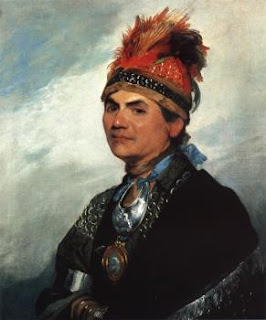 |
| Joseph Brant |
Molly and her seven-years-younger brother were always close. During the American Revolution she constantly worried about his whereabouts and his safety. After the war the Canadian government built both Molly and Joseph houses in Cataraqui adjacent to one another because they knew of this closeness.
I'm actually grateful that so much has been written about Joseph Brant because Molly's life runs like a thread through his, and we are able to infer much of Molly's story from that of her warrior brother.
Did you have a specific readership in mind when you wrote your book?
The Quest Biographies are written for a high school reading level, with some crossover to adult. That suits me well because that seems to be most natural for me. Even when I was writing novels for young readers, I never intentionally changed my style. I'm not a scholarly writer. My style, I think, is more folksy. People tell me my historical biographies are very readable, and that pleases me.
What are you reading right now?
I'm always guilty of reading several books at the same time. I'm currently reading Charlotte Gray's biography, Sisters in the Wilderness: the Lives of Susanna Moodie and Catharine Parr Trail. I'm also reading Songs in Ordinary Time, by Mary McGarry Morris. I just finished All the Light We Cannot See by Anthony Doerr. It will go on my list of all time favourite reads.

The month of June is almost over. We've been living at our cottage for the past four weeks while renovations are taking place at home. I feel a little out of touch; the calendars in the house are still turned to May. With no internet connection at the lake, I've driven to the nearest public library and used their free wi-fi in order to check my email. But there's never enough time for social media conversations. Are you still there, Twitter?
We've had a wet June in this part of the province, with torrential downpours that left puddles the size of small lakes in front of the cottage. The robins loved it, anyway. I've spent my time reading, writing, and taking brisk walks. I even managed to do a thorough clean-up inside, emptied cupboards that hadn't had the shelf paper changed in years! I got all the windows cleaned too, which is more than I can say about the windows at home. I shudder to think about the gardening I should be doing. On the few quick trips back to the house to do laundry, buy groceries, and have a hot shower, I've only stayed long enough to dead-head a few of the flowers. The weeds are knee high.
We've never "opened" the cottage this early in the season. Nights are still cold at the lake in June, making it necessary to haul the flannelette bedding and the feather duvet from home.
But if the sun is shining and you can position your lawn chair out of the persistent wind, it is pleasant to sit outside and savour the first days of summer.
Enjoy!
Who was it? That was the question the writing prompt asked, suggesting I write one page. I didn't have to think about it for long. The scariest person I can remember was actually two persons.
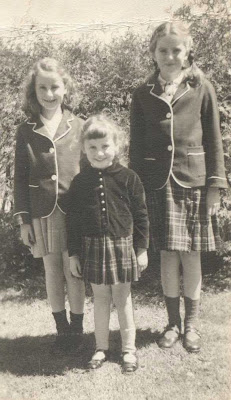 |
Taken at our house along the Richelieu. Myself, my younger sister, and my older sister.
|
On the corner of the lane that ran behind the houses on our street was the home of the cross-eyed boys. At least, that's how my sister and I referred to them (but only to each other, of course). Was it just one of them whose eyes were crossed? Or were they both similarly afflicted?
Adding to their mystic was their mother, who operated the wringer washing machine on their back porch, scowling at us with suspicion whenever we passed, and whose left arm had been mysteriously amputated above the elbow.
My older sister and I walked to school together every morning, with no problem. But if she was staying after school to play ball or going in the other direction with her friends, I had to walk home alone. There was no way to avoid the big clapboard house that occupied a corner on the side street that I had to take in order to reach either the lane that ended at our backyard or Richelieu Road that passed our front hedge.
The school the boys went to must have finished each day before our final bell rang, because invariably the brothers would be lying in wait for me. They'd dash across their yard, screeching to a stop within inches of my terrified person, jumping up and down and hurling curses in their native French-Canadian while I scurried past, looking straight ahead, the back of my neck feeling the heat of their scorn. I was sure it was only a matter of time before they grabbed me. It never occurred to my nine-year-old self that it was all an act.
Not content in knowing that this skinny English-speaking girl was deathly afraid of them, one afternoon they enhanced their performance to include spitting. Luckily for me, their mother was on the porch, threading wet clothes through the wringer. "Ici," she shouted. "Vite!"
All three of us came to attention, and the boys slunk back across the stony yard. Maman tromped down the steps, grabbed the boys and held them to her with her one good arm. Then she twisted the ear of first one and then the other, till they shrieked in pain and batted her off.
By this time I'd escaped. But now I had to worry what special sort of revenge I was in for next time.
It's up to us, you know. A book doesn't sell itself.
Unless you happen to be a famous author whose reading public has been waiting months for your next bestseller.
For the rest of us with a new book about to hit the shelves, it's time to get on with spreading the news. For me, this is the hardest part of the whole process. Most of us would rather just keep writing. But we owe it to our book and all the hours we've put into it, and to the publisher who has put his faith, not to mention his finances, into bringing forth our creations.
My publisher has assigned me a publicist, and I'm grateful for that. For a while now she's been alerting the media, sending out press releases and review copies. But she also has a hundred other titles to promote, this year alone. So, the rest is up to me. Hence the long list of places to send my author flyer, bookstores to visit, libraries to contact, family and friends to invite to my events, announcements to make both online and in print, updates to prepare for my own website, and dates to keep track of on when to post on social media.
I'm officially launching Molly Brant on May 2nd at Lighthouse Books in Brighton, Ontario, between noon and 2 p.m. Above is the invitation, so if you live in the area, consider yourself invited. We tied the launch into the Authors for Indies event already scheduled for May 2nd. I think that was a great idea. Sometimes we need to join forces, and since there will be people coming to the store that day anyway, why not?
Today, I'm being interviewed by the local press, and on Thursday, by the radio. On May 16th from noon till 2 p.m. I'm doing a book signing at Chapters, Belleville. And that, I hope, is just the beginning.
Stay tuned!
As soon as I saw the cover of Jane Urquhart's new book,
The Night Stages, due to be released in April, I was struck by how similar the cover is to that on my middle grade novel,
Growing Up Ivy, published by Dundurn in 2010.
Do you see it? Or is it only me?
Both stunning covers, anyway. And I am happy to be in any kind of company that includes Jane Urquhart.
Finding Celia
While I was researching Molly Brant for my upcoming book, I encountered another interesting woman. I would loved to have met her in person, but she was of my grandmother's generation. She died in 1973.
Celia B. File was born Celia Vandervoort in 1887 in Napanee, Ontario. As an adult she was a farmer's wife as well as a school teacher. For six years she taught at the Mohawk Central School at Tyendinaga.
That experience turned her preconceived, racist opinions of Native people upside down, so much so that she called the six years she spent living among the Mohawk the happiest years of her life. She was given a courtesy title by the Mohawk at Tyendinaga —
Kanoerohnkwa — meaning the loving-hearted, for her unselfish devotion as a teacher, nurse, and friend.
* * *
It had seemed only logical for me to begin my research on Molly Brant at the Tyendinaga Mohawk Library. It was an easy forty-minute drive from my home. It was here that I learned about author and poet Beth Brant, who'd grown up at Tyendinaga with her father's family, and who had fairly recently returned to the library to work on a special project, collecting stories from the Mohawk elders. The end result of this was Brant's book titled
I'll Sing Till the Day I die: Conversations with Tyendinaga Elders (McGilligan Books, Toronto, 1995).
 |
| Kanhiote – Tyendinaga Public Library. Photo from library's website. |
One of the elders Brant interviewed recalled that during the 1920s there'd been a white woman teaching school on the Reserve. AND this woman was writing a book about Molly Brant. NOW I was really intrigued!
Who was this woman? And where was her book now? Was it ever published?During the course of my investigation I learned that the teacher's name was Celia File and that what she was writing would become her Masters thesis in 1930.
She'd been teaching at Tyendinaga about three years when she became an extramural student at Queen's. Eventually she made the decision to become a full time student and said a sad goodbye to her little school and all her Native friends. She admitted that the love of study had gotten the upper hand.
In 1929 Celia B. File earned an honours degree in English and history and won the Sir James Aikens Fellowship in Colonial History. That meant her M.A. She'd spent a summer working at the Public Archives in Ottawa and she wrote that Molly Brant kept "thrusting herself into the limelight." Celia knew she had found the topic for her thesis.
 |
| Bust of Molly Brant at Rideaucrest Nursing Home, Kingston. |
When the thesis was accepted File wrote that she wouldn't say it was completed, for "the woman will not let me go." She had become obsessed with her subject,
It was only natural that she would go on to write a book. How disappointing to learn that before the book was published the manuscript was lost in a fire, while Celia was teaching at Oil Springs, Ontario. She never felt well enough to rewrite it.
It's a bit late in my life to confess this, but writing is hard for me.
It doesn't come easily. Stories don't fly off the ends of my fingers onto the computer — or in my case, out the end of my pen; computers are for later drafts.
When I was a kid my head was full of story ideas. Now, not so much. I wonder if it is because I've since learned about all the elements a good story is supposed to have — conflict, inciting incident, a story arc. Am I worrying to much about this and blocking my creative flow, being forced into deliberate thinking?
But even before all the how-to books, I was never one of those brilliant writers who could hardly wait to finish one story to start the next, because they already knew what the next one, or the next half-dozen, was going to be about. I am envious of writers with such skill, and honestly, I don't want to hear about it.
It used to take me agonizing months of Morning Pages before I'd finally discover a character taking shape on the paper, someone I could feel empathy for and work with.
Maybe that is why I've lately preferred writing non-fiction and have published two biographies, with the third to be released in a few weeks. It's the research into the subject that has opened the doors and let me start a new project. I love the research. And maybe that's not such a bad thing.
Write on!
This was Molly Brant's house, her home during her happiest years. I like to think her spirit is still there.
It was here in 1763 that she and her partner, Sir William Johnson, moved their young family, even though construction on the manor house was not fully finished.
Molly and William had two young children at the time — Peter, who was four, and Elizabeth, just two years old. Baby Magdalene would be born that same year; perhaps Molly was pregnant during the move.
Over the next eleven years more babies would arrive — Margaret, George, Mary, Susanna, and Anne.
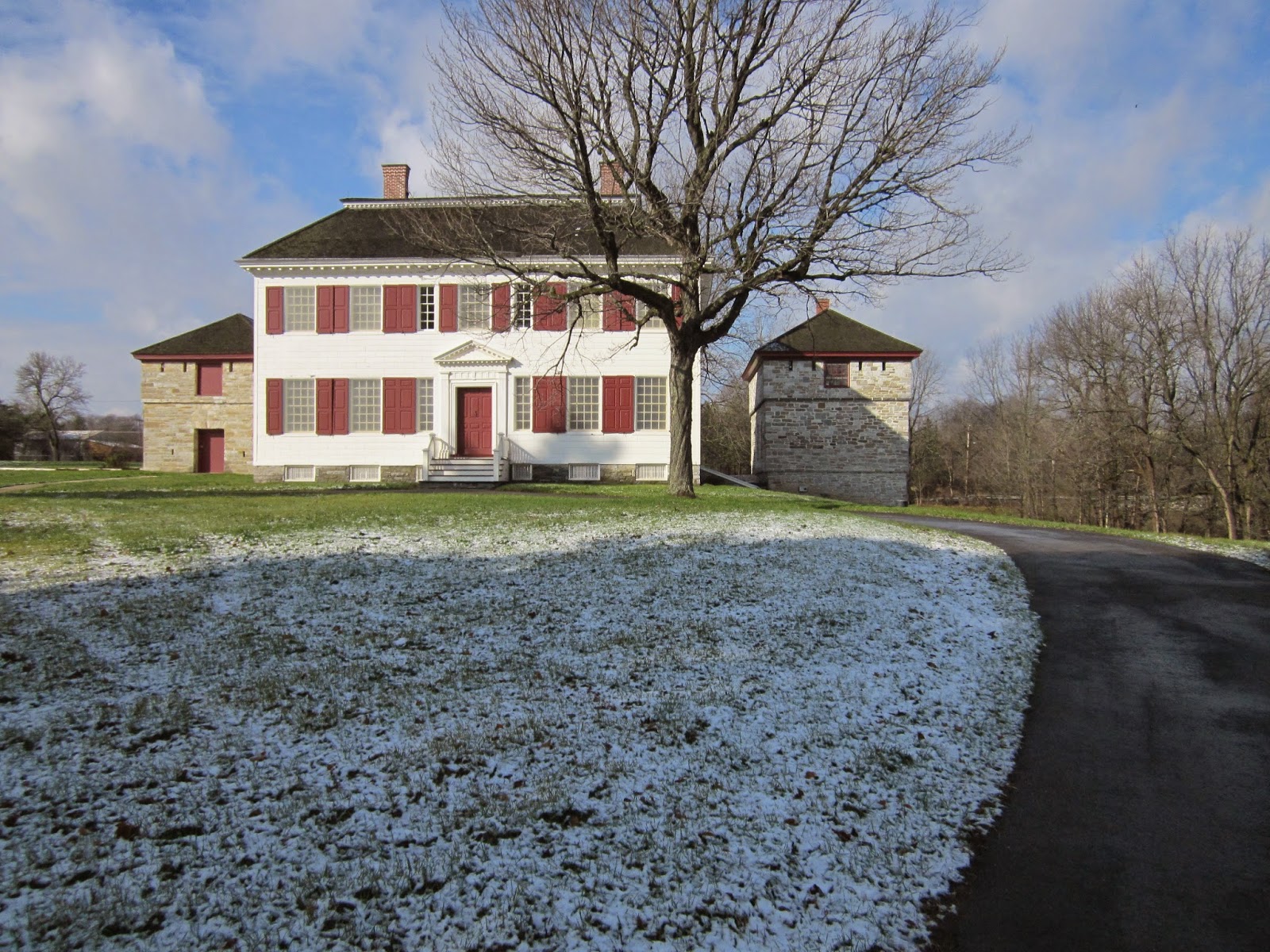 |
Johnson Hall, closed for the season.
|
The family had moved from their former home, Fort Johnson (pictured below), on the Mohawk River, three miles west of Amsterdam, New York.
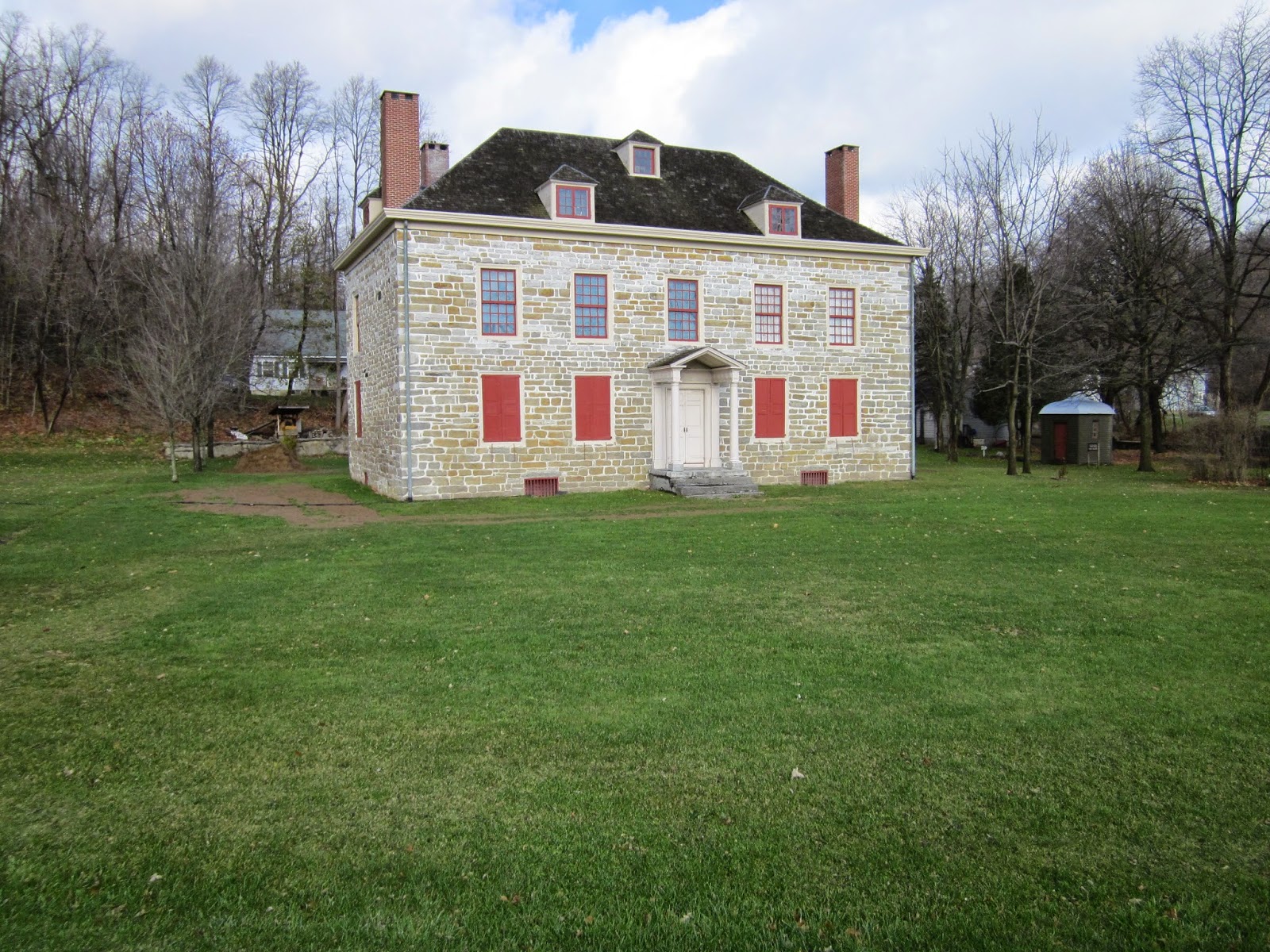 |
Fort Johnson
|
The new house, north and west of Fort Johnson, was nine miles back from the Mohawk. It was bigger and more elegant than Fort Johnson.
Johnson Hall is a New York State Historic Site, open to the public. Currently, it is having some of its rooms refurbished. I recently saw pictures on the Facebook page of Johnson Hall State Historic Site that showed painting and other restorations being done in the children's room.
The first children ever to use that room were those of Molly Brant. I love to imagine the halls of the stately home echoing with the sounds of Molly's children.
It was at Johnson Hall that Molly Brant proved her mettle as Mistress of the Manor. She and William hosted elaborate dinner parties and entertained visiting dignitaries, both white and Native. Sir William was Superintendent of Indian Affairs for the Northern District and frequently held meetings with the Six Nations, right there on the grounds of Johnson Hall.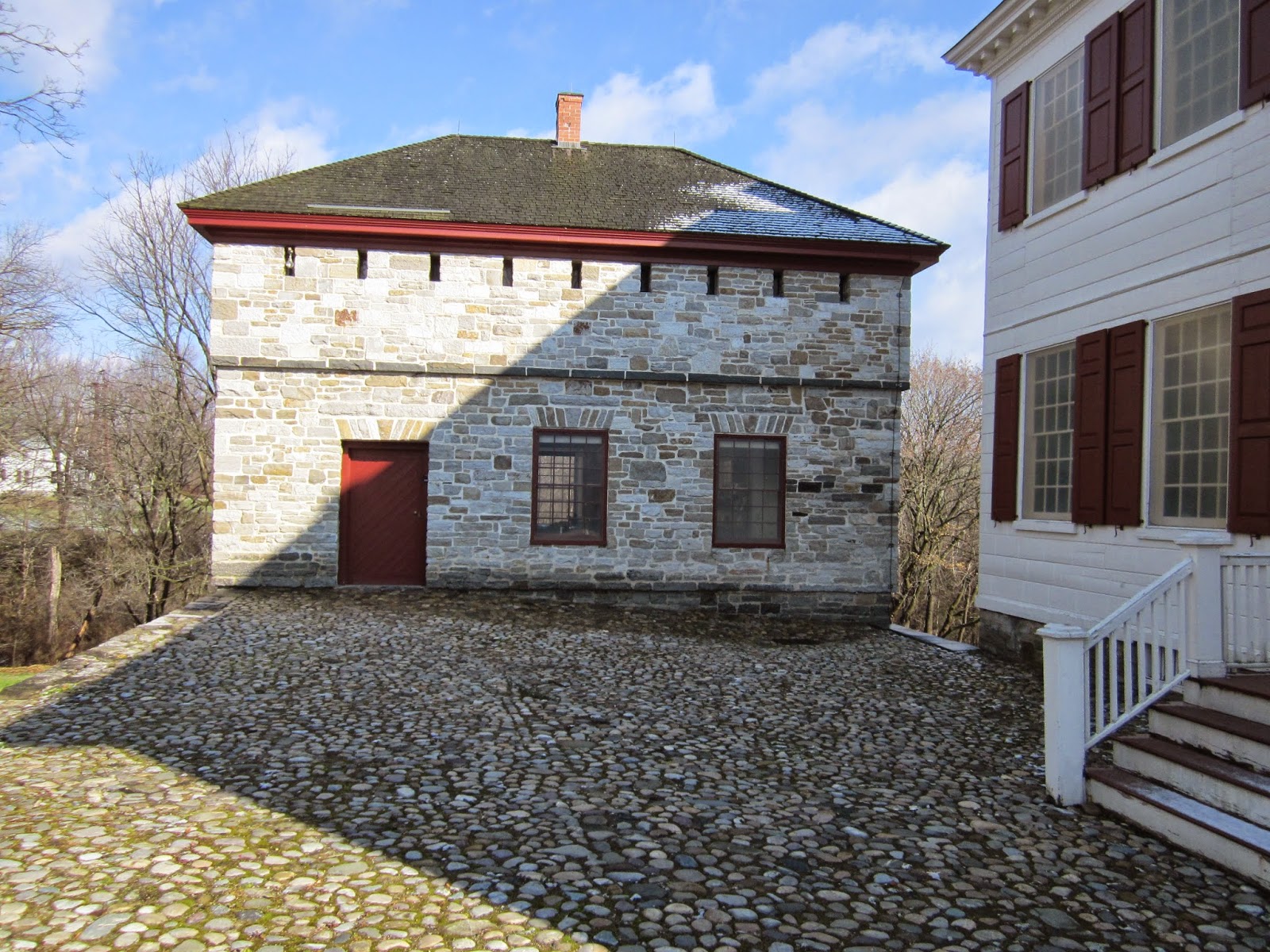 |
| View of the back of Johnson Hall, showing one of the two stone blockhouses. |
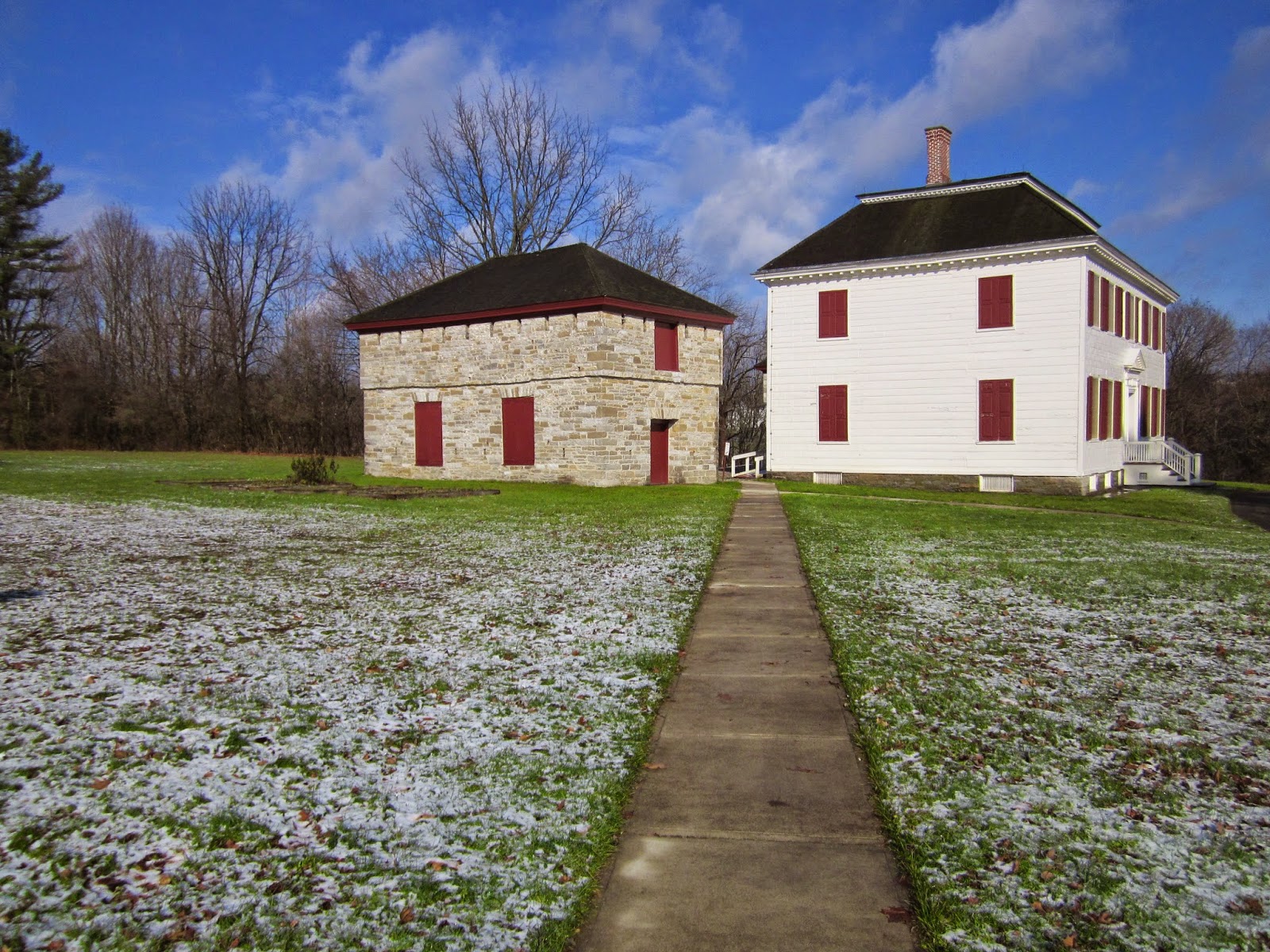 |
| Approaching Johnson Hall from the side, showing first of two stone blockhouses. |
Molly lived at Johnson Hall until Sir William's death in 1774. After that, she took the children and returned to her Mohawk town of Canajoharie.
Sir John Johnson, William's principal heir and the son of Catherine Weissenburg, moved his family into the manor house. In 1776, during the American Revolution, Sir John fled to Canada, and Johnson Hall fell into the hands of the Patriots.
For more on this story, Molly Brant, Mohawk Loyalist & Diplomat, available in April, 2015
By:
Peggy Dymond Leavey,
on 1/1/2015
Blog:
Peggy Dymond Leavey- children's writer
(
Login to Add to MyJacketFlap)
JacketFlap tags:
American Revolution,
Kingston,
Peggy Dymond Leavey,
Molly Brant,
Cataraqui,
Carleton Island,
Fort Frontenac,
Mohawk River Valley,
Rev. John Stuart,
St. George's Anglican Church,
Add a tag
 |
St. George's Anglican Cathedral, Kingston.
(tourism.kingstoncanada.com)
|
Did you know that Molly Brant, the subject of my upcoming biography, was the only female founding member of St. George's Anglican Church in Kingston. Ontario?
The idea of such a thing would've have been beyond the wildest imaginings of the Native girl, born in 1736 in poverty, in the Mohawk Valley of New York State. But here's how it came about:
The Rev. John Stuart, a Loyalist refugee from New York and a missionary to the Mohawk community there and later, in Montreal, petitioned for land at Cataraqui in December 1783. He applied to become chaplain of the troops stationed at old Fort Frontenac.
Stuart arrived in the spring of 1784, around the same time as Molly Brant, then about forty-seven years of age, and her family. The Canadian government, in recognition and appreciation of the service Molly had given this country during and after the American Revolution, was building Molly a comfortable house in the town, and saw to her relocation from her former home on nearby Carleton Island.
There was no church building in Cataraqui (Kingston) when Stuart and Molly arrived, and the commanding officer allowed Stuart to use a large room in the garrison as a place of worship. Soon the local inhabitants, including Molly, began turning out for Sunday services.
Shortly, Stuart was writing his bishop that his congregation had grown so large that the room they were using above the barracks could scarcely hold them all. The Reverend began to raise funds for a new church, starting by donating the first ten pounds himself.
Among the names of those who contributed to the building fund was that of Molly Brant. She was the only woman in the 1792 founding charter of the first St. George's Anglican Church. A memorial plaque inside today's magnificent Cathedral Church of St. George tells the story.
You can read more about this remarkable woman in
Molly Brant, Mohawk Loyalist & Diplomat, to be released in April of this year.
Coming soon!
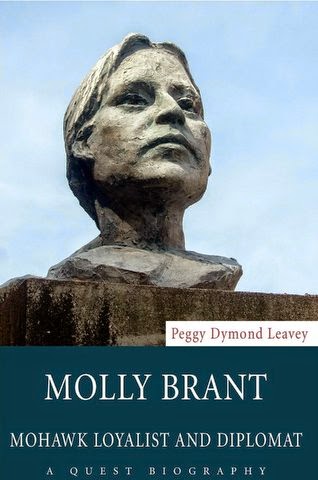 |
| Available April, 2015. |
Exciting News!! Last week I learned the production schedule for the publication of my latest book,
Molly Brant, Mohawk Loyalist & Diplomat. It's been nine long months since I met the deadline for submitting the finished manuscript to Dundurn Press, my publisher. The contract between us had been signed early in January, 2014. I am really looking forward to getting back to work on it. I'm confident that Molly's story will come alive for me once more. She was a totally fascinating woman.
My editor tells me that the copy edit begins January 5, 2015, and that I will have the week of January 16–23 to review and approve of any changes. The book goes into design January 30th, and I will be able to review the typeset manuscript between February 6–13. This is the stage where it really starts to look like a finished book.
Late last summer, when I re-read the manuscript, fearing after all that time I might have forgotten what I'd written, I did a bit of fine tuning and began a list of subjects for the index of the book. The editors will complete the index, matching subjects to page numbers, February 20–27.
Then, it's off to the printers on March 9th. Further updates as I receive them. Stay tuned!
 |
| Town of Saranac Lake |
On a recent trip to Saranac Lake, NY, our favourite vacation spot in the Adirondack Mountains, I toured the Robert Louis Stevenson Cottage & Museum. Its four small rooms contain the world's finest collection of Stevenson memorabilia.
When I think of Robert Louis Stevenson I hear my dad reading
Treasure Island to us as children, but I also remember some of Stevenson's poetry, particularly
My Shadow, the first verse of which I still know by heart.
"I have a little shadow that goes in and out with me,
And what can be the use of him is more than I can see.
He is very, very like me from the heels up to the head,
And I see him jump before me, when I jump into my bed."
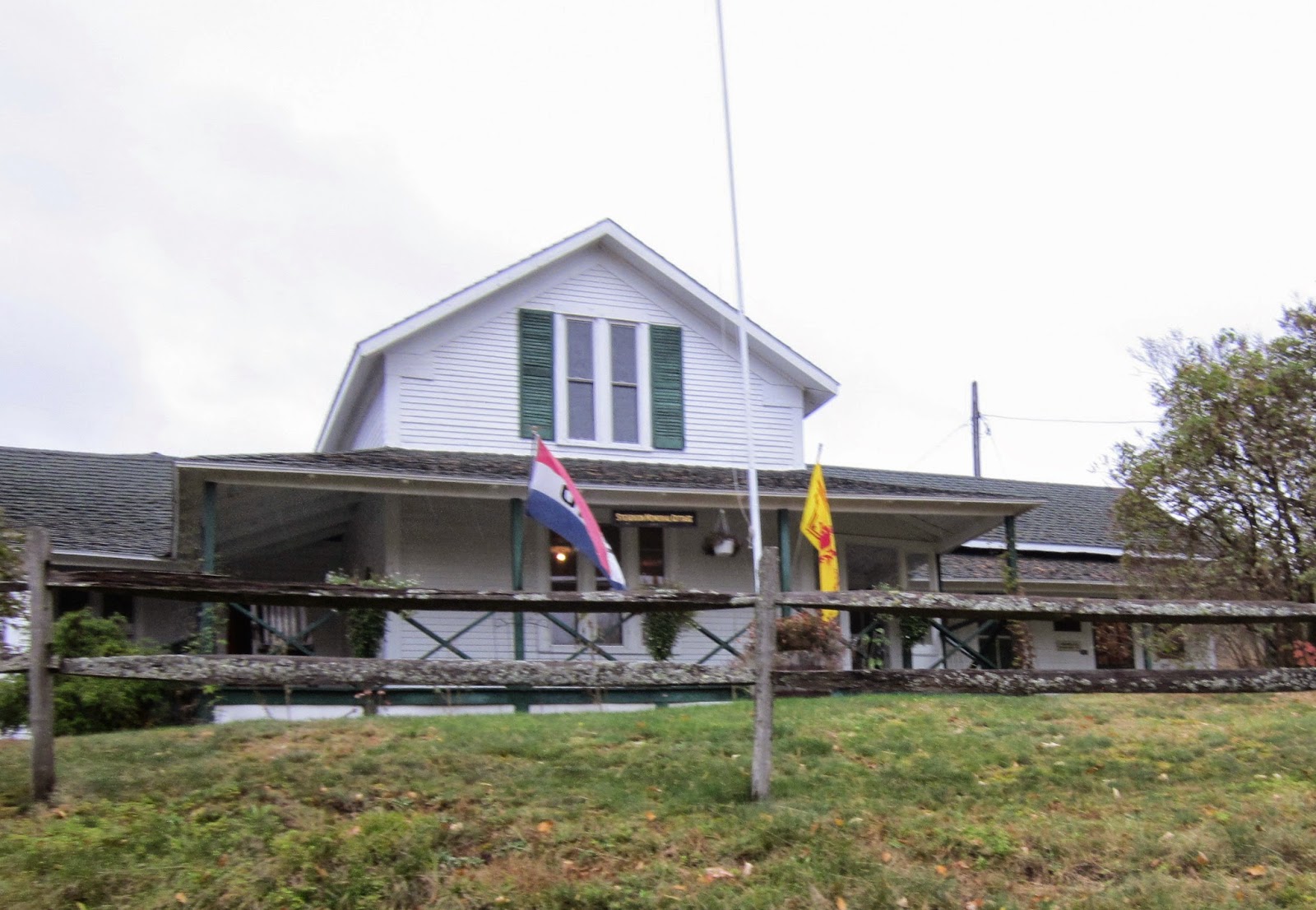 |
| The Baker farmhouse. The Stevensons rented the section on the east side. |
Robert Louis Stevenson rented part of this house, then owned by the Baker family, in 1887 when he came to Saranac Lake seeking a cure for what his doctors thought was tuberculosis.
In 1884 Dr. Edward Livingston Trudeau had founded the first successful sanatorium in the US for the treatment of TB at Saranac Lake, and the town became the Pioneering Health Resort in the 1870s. Thousands of TB sufferers flocked to Saranac Lake for the tuberculosis cure, which featured lots of fresh air, a nutritious diet, a positive outlook, and long hours spent resting outdoors, even during the winter when they bundled up and slept outside on the porches.
Born in Edinburgh, Scotland in 1850, Robert Louis Stevenson was the acclaimed author of
Treasure Island (1883),
Kidnapped (1886),
The Strange Case of Dr. Jekyll & Mr. Hyde (1886). He was already famous when he sailed into New York Harbour from Bournemouth, England, bound for the clean mountain air of Saranac Lake.
 |
| Stevenson's writing desk in the cottage. |
While he was living in Saranac Lake, Stevenson wrote twelve essays as the Scribner's series
The Master of Ballantrae and
The Wrong Box. 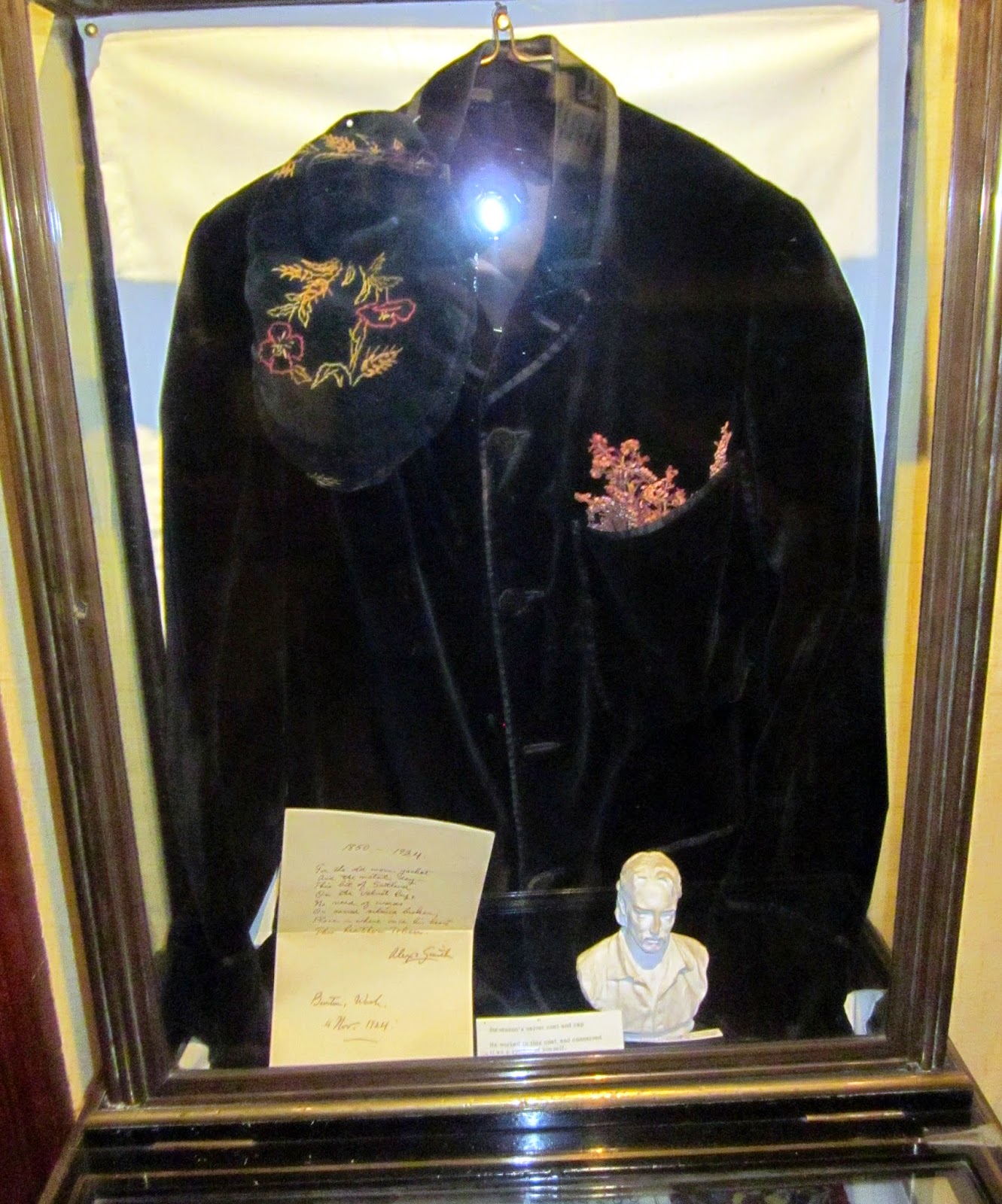 |
| RLS's smoking jacket, a sprig of heather in the pocket. |
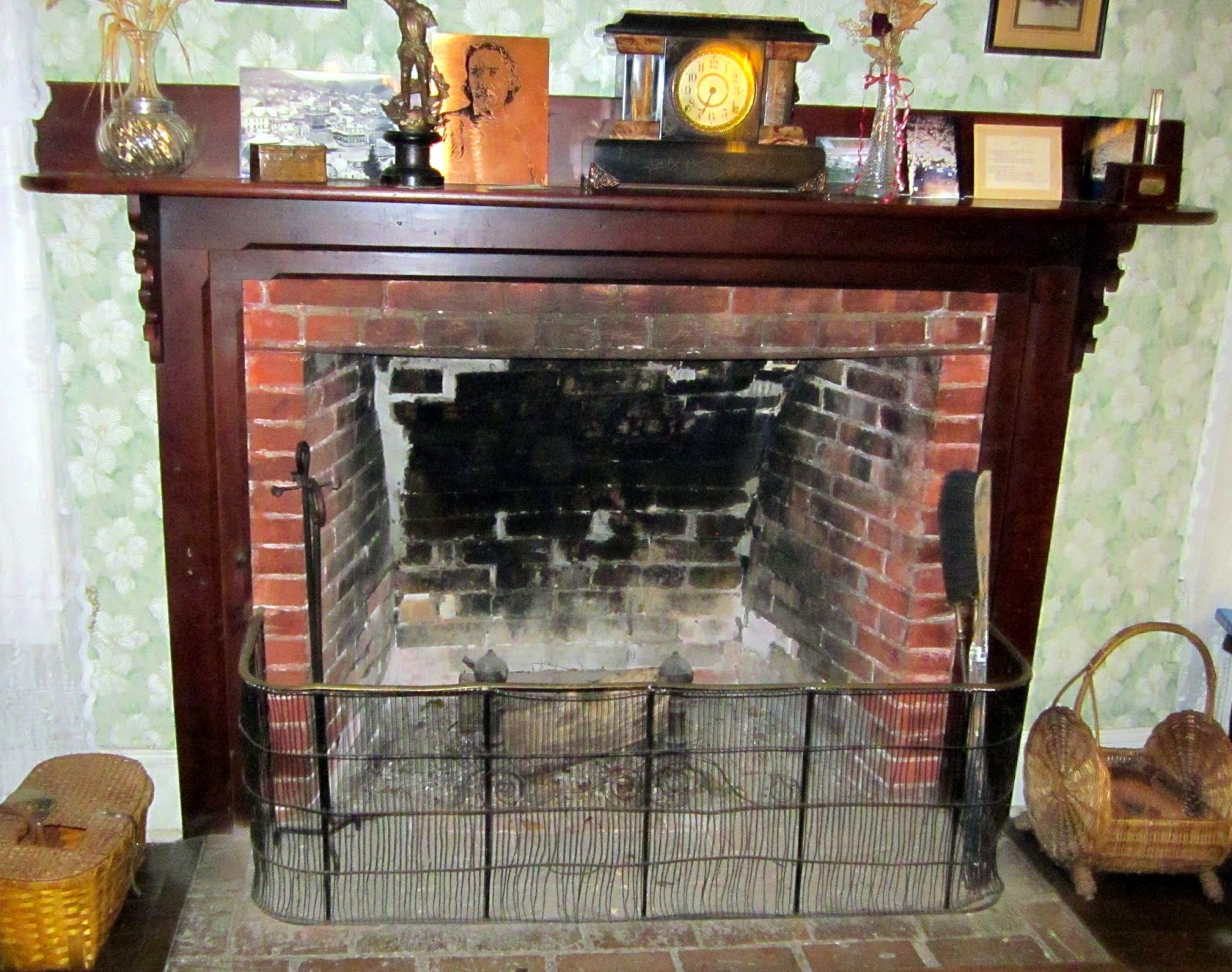 |
Fireplace in the Stevenson cottage. Although RLS spent many hours writing in bed,
propped up on pillows, the mantle on the fireplace is scarred
where Stevenson left cigarettes burning. |
Stevenson's wife Fanny found the mountain air very cold, and she writes of going to Montreal "to buy extraordinary garments made by the Canadian Indians." She returned with buffalo skins, snow shoes, and fur caps.
"Louis wants to have his photograph taken in his, hoping to pass for a mighty hunter or sly trapper. He is now more like the hardy mountaineers, taking long walks on the hill tops in all seasons and weather." He also enjoyed skating on the ice of nearby Moody Pond.
A seasoned world traveller, it is said of Stevenson that always fancied himself a hunter, although he also dreamed of living in the South Seas. He prospered financially from his writing, and when he died in 1894 at the age of forty-four, he was living in the Samoan Islands.
Under a wide and starry sky,
Dig the grave and let me lie,
Glad did I live and gladly die,
And I laid me down with a will.
This be the verse you grave for me:
Here he lies where he longed to be,
Home is the sailor, home from the sea.
And the hunter home from the hill.
Requiem, by Robert Louis Stevenson (1850–1894)
By:
Peggy Dymond Leavey,
on 9/26/2014
Blog:
Peggy Dymond Leavey- children's writer
(
Login to Add to MyJacketFlap)
JacketFlap tags:
Peggy Dymond Leavey,
Franklin W. Dixon,
Haileybury fire,
Haileybury ON,
Lake Tamiskaming,
Leslie McFarlane,
reading,
Canadian history,
Nancy Drew,
The Hardy Boys,
Add a tag
 |
| Haileybury Marina on Lake Tamiskaming. |
Earlier this month we took a road trip through Ontario's "Near North," stopping one night at Haileybury. We knew nothing about this small town whose main street runs steeply downhill to Lake Tamiskaming.
I'd been intrigued by the sign on the way in, informing us that Haileybury was the home of Leslie McFarlane (1902–1977), the author of the first books in
The Hardy Boys mystery series.
At breakfast the next morning our friendly host at the motel was able to tell us more about his town.
McFarlane grew up in Haileybury, the son of a school principal. The youth went on to become a respected journalist, author, playwright, screen writer, and film director. But he is best known as the man who wrote
The Hardy Boys. In all, there were fifty-eight volumes in the popular series, beginning in 1927. The books were written by various authors, all using the pseudonym "Franklin W. Dixon". McFarlane wrote volumes 1–16 and 22–24.
As a kid I loved the Hardy Boys books. They, and the Nancy Drew series, got me hooked on reading.
My father read us the classics, but I loved Frank and Joe Hardy. These were the books I read by flashlight under the covers.
Others might consider such books formulaic junk, but at least I was was a kid who was reading. And that's a habit that's lasted all my life.
 |
Pioneers' Monument, Haileybury ON
|
Before we left Haileybury we strolled its picturesque waterfront on Lake Tamiskaming in early morning sunshine. In the park at the marina a sculpture called "Pioneers' Monument" caught our attention. Sculpted by Ernie Fauvelle, it depicts a man on the shore handing a child to a woman who is waist-deep in the water.
The story behind it is that in 1922 the town stood in the path of a raging wildfire that went on to consume 650 square miles. Fanned by strong winds, the fire destroyed 90% of the town of Haileybury on October 4, 1922, all within 3–6 hours.
Only Lake Tamiskaming saved the inhabitants who fled their homes and ran for the lake, getting as far out into it as they could. After it was over, 3500 had been left homeless and eleven people died. It was one of the worst natural disasters in Canadian history.
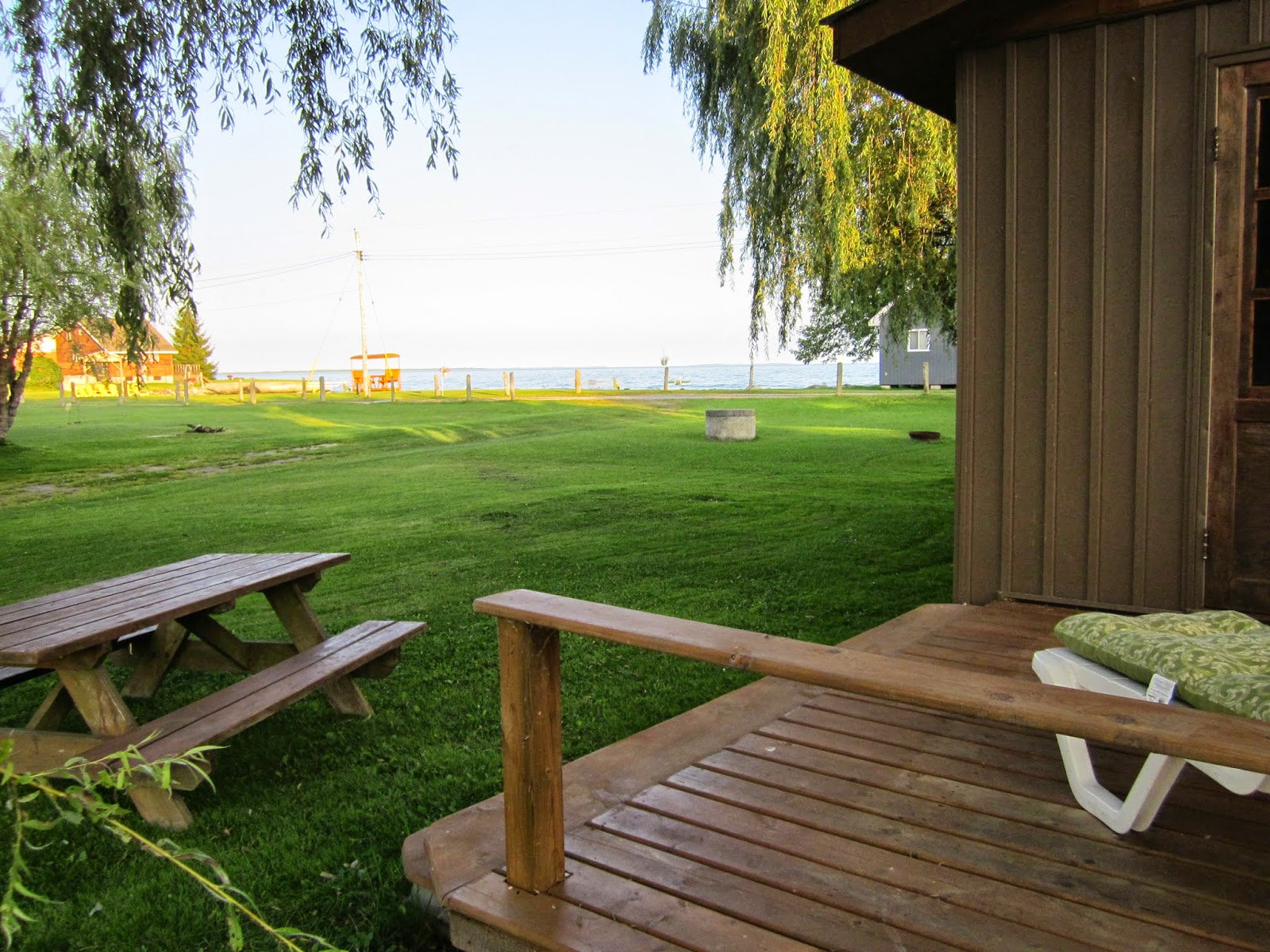 |
| An evening view of Lake Ontario off Shoal Point |
It appears the rain is over. This morning pale sunlight filters through the clouds on the last day of August. I sit on the deck of the cottage and watch the waves roll in and crash on the shore, pushing weeds and sand off the lake bottom. Already the youths who look after the grounds are raking the beach. The raft off shore dips and bobs.
I am trying to read but I'm watching and listening. I think this is the curse of being a writer. Why must I always find words for what I am feeling? Always the urge to record my experiences — the sound of the breeze rustling the willows, the gentle clink of the shells in the wind chimes we've hung off the end of the deck, the thunder of the waves. Why can't I just relax and let things happen around me?
If you are a writer, can you relate? Can you put your pen down and just breath? Perhaps this doesn't happen in this age of technology, when people no longer carry notebooks and pens with them for recording what's around them. A curse? Or a blessing?
By:
Peggy Dymond Leavey,
on 8/28/2014
Blog:
Peggy Dymond Leavey- children's writer
(
Login to Add to MyJacketFlap)
JacketFlap tags:
Upper Canada,
Peggy Dymond Leavey,
Molly Brant,
Loyalist,
Sir John Graves Simcoe,
Mohawk Loyalist and Diplomat,
Clarissa Putnam,
Indian Department,
Mont Saint Gregoire,
Sir John Johnson,
Add a tag
Sir John Johnson, Molly Brant's stepson, a champion of Native causes, and Molly's life-long friend.
 |
| Sir John Johnson, 1742–1830 |
http://montreal.ctvnews.ca/video?clipId=423539&playlistId=1.1973035&binId=1.1332485&playlistPageNum=1 (Click on the link above to view a video clip from CTV Montreal on the return of Sir John's remains to his beloved home.)
In 1791 Lord Dorchester, Governor of the two Canadas, recommended Sir John Johnson as first Lieutenant-Governor of Upper Canada. Because Sir John had supervised the crucial settlements of Loyalists on the upper St. Lawrence and the Bay of Quinte, everyone expected that post would be his. In fact, Sir John had already named to his Executive Council two of Molly Brant's sons-in-law, Captain George Farley and Dr. Robert Kerr.
But instead of the obvious favourite of the people, Sir John was passed over and John Graves Simcoe was chosen as Upper Canada's first Lieutenant-Governor. Deeply disappointed, Sir John took his family away to England where they stayed for four years.
When he returned to this country Sir John was appointed to the Legislative Council of Lower Canada (Quebec), and he took back his position as head of the Indian Department.
One of Johnson's many residences was on the south shore of the St. Lawrence at Mont Saint Gregoire. (It was here the his remains were recently interred, see news clip above.) Sir John named his home "Mount Johnson," after the Mohawk Valley house near Amsterdam, NY where he was born. He and his wife Polly Watts, daughter of wealthy New York parents, raised a large family.
Interestingly, before marrying Polly, he'd had a common-law relationship with Clarissa Putnam, a farmer's daughter who had been deemed by Sir John's father, Sir William, not suitable to bear his grandchildren. The couple had two children however, and Sir John and Clarissa maintained a fondness for each other for the rest of their lives. Their daughter Peggy came to live with Sir John after the death of Polly, looking after him till his own death in 1830.
You'll find more stories about Sir John and Clarissa in
Molly Brant, Mohawk Loyalist & Diplomat to be released by Dundurn in April, 2015.
August 5th, A Pivotal Day in the Life of Molly Brant
 |
| To be released by Dundurn Press, April 2015. |
Molly Brant, Mohawk widow of Sir William Johnson, one of the most influential white men in 18th century New York, had taken their children and moved back to her native village of Canajoharie after his death.
There, a loyal supporter of the British monarchy, Molly began watching the movements of one of her neighbours — General Nicholas Herkimer. Through her surveillance she learned that he was planning to take the entire Tryon County militia to aid in the defence of Fort Stanwix, already under siege by British forces and their native allies.
On August 5, 1777 Molly sent a native runner to warn her brother, Joseph Brant, that the rebel militia — some 800 strong — was on its way.
After the bloody encounter that ensued, the Americans were more than ever convinced that Molly Brant was a spy for the British. Subsequently, they harrassed her, threatened her, stole her cattle, even murdered her foreman, until she and the children were forced to flee for their lives.
Stay tuned for further previews!
Molly Brant, Mohawk Loyalist & Diplomat
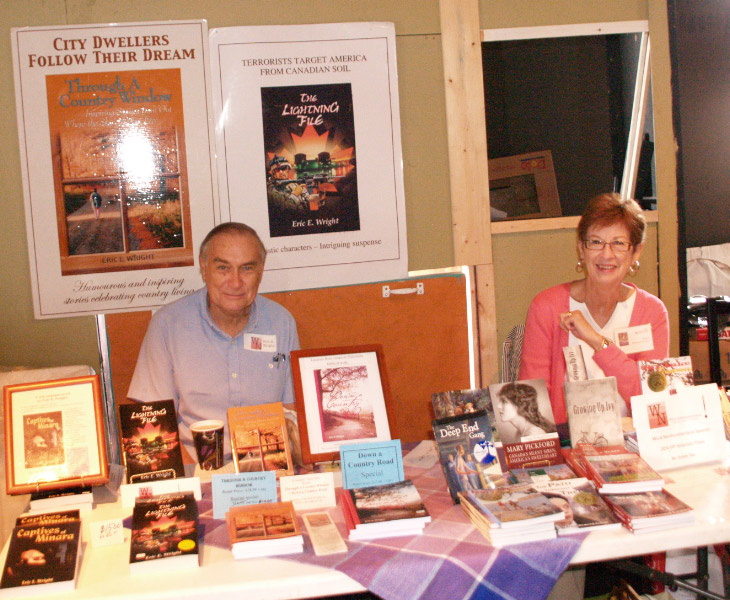 |
| Author Eric E. Wright & I shared a table at Word Northumberland in 2013. |
Sometimes, in spite of doing everything right — having a well-thought out and attractive display, using clear signage and balloons to draw attention, having bookmarks printed with all your covers and contact information — your sales at the local art festival are dismal. Almost non-existent, in fact.
If the public doesn't come, nothing works.
This is what happened a couple of Fridays ago. It didn't just happen to me; none of the other artists did well. The riverfront venue was perfect, the day full of warm sunshine and cool breezes. But the people preferred the carnival atmosphere and they stayed on the main street with the food vendors, the musical acts, the racks of bright summer togs, and the guy making balloon animals.
Thankfully, experience has taught me to be prepared for such occasions and I had taken along two pieces of writing to work on, printing them off the computer the day before so that I could read them over and make revisions by hand. The organizers of the art festival had suggested we artists be demonstrating our craft for the public, and as it happened I had five long hours to do just that.
So, it wasn't a total bust. I did meet several interesting people, and I made good headway on editing two manuscripts.
Write on!
Recently I was interviewed about my writing for the radio show
The Word on the Hills on Northumberland 89.7 FM.
Here is the link where you can hear me chatting with Felicity Sidnell-Reid and Gwynn Scheltema, co-hosts of the program.
http://wordonthehills.com/2014/06/12/peggy-dymond-leavey-2/The interview is in two parts, each lasting about 10 minutes. They conclude with a short reading from
Mary Pickford and
Growing Up Ivy, two of my books.
In the first section we talk about the benefits of belonging to writers' organizations, my love of researching the subjects for the biographies, and what influences my writing choices.
Part 2 deals with writing for children and the place reading had in my early years. Doesn't everyone love to talk about their favourite books? It's surprising how many of us writers were influenced by the same great books.
Here is the first look at the cover of my next book,
Molly Brant, Mohawk Loyalist and Diplomat (Dundurn Press, Spring 2015.) The publisher's design team emailed it to me earlier this week. I think it's stunning.
The photo of John Boxtel's sculpture of the bust of Molly Brant was taken by Mark Bergin. The book is one in Dundurn's popular Quest Biography Series.
Seeing for the first time the cover treatment for a new book is always exciting, as every author knows. I'll never forget the day I received the artist's rough for my first novel for young readers,
Help Wanted: Wednesdays's Only.
In those days, twenty years ago now, one received these things in the mail. Opening that big, brown envelope to reveal Greg Ruhl's wonderful coloured illustration is still one of the highlights of my writing life. The thrill of anticipation never gets old.
Happy National Aboriginal Day to all my First Nations friends! Here's to you, Molly Brant.
When I was growing up, my mother always prepared a big meal for a one-o'clock Sunday dinner — a roast of some sort, usually beef, less often pork or lamb. As a treat for my British-born father, the roast beef would occasionally be accompanied by Yorkshire pudding. There would always be at least two different kinds of vegetables, as well as potatoes that had been added to the roast pan and were served brown and crispy on the outside. We could also expect a dessert of pie or trifle. Tarts and cake were reserved for our evening tea. My mother would have spent all Saturday afternoon baking, while she listened to the radio broadcast of the Metropolitan Opera Company from New York.
The only downside to that fabulous meal would be the scene of devastation in the kitchen, the mountain of dirty dishes that awaited my teen-aged sister and me. The Yorkshire puddings alone had resulted in blackened muffin tins, encrusted with baked-on food. These were the days before no-stick cookware. And the roast pan? I learned quickly that if I complained enough I might just hear, "Just leave it to soak, dear."
My parents would take their coffee to the living room to relax, while my sister and I would battle it out over who would wash and who would dry. We were forbidden from flicking wet towels at each other — tea towels were kept clean and never flung over the shoulder to pick up hair or worse (gasp) dandruff. I do remember getting in a few swipes with the dish-mop, though. Our dad, by this time, would have retreated into his garden.
Mom finally settled on a system where the one who did the drying waited until the dishes had been washed, stacked in the rack, and laid out on clean tea towels on the counter before entering the room.
Sunday dinners were served in the dining room, the table set with a table cloth and napkins. There were plenty of rules when it came to eating in that household. No elbows on the table, no pushing peas onto your fork with your fingers, no feet on the rungs of the chair.
I admire my mother for sticking to the tradition of the Sunday family dinner where everyone sat down at the table together. We didn't always make it easy for her. I also appreciate that our parents taught the five of us proper table manners, how to set a formal dinner table, and how to handle a knife and fork.
We all make our own rituals and, good or bad, the formal Sunday dinner disappeared fairly early in my own household. Along with a few of the rules, although not the table manners.
The most valuable lesson I learned at my parents' table was the importance of family regularly sitting down together to share a meal and conversation. Whatever day of the week it happens to be.
Do you have particular traditions when it comes to meals at your house? Are they harder to uphold as your children get older?
 |
| School Days |
In next to no time school will be out for the summer and many teenagers will be looking for work. College and university students have been out there already for weeks. I hope all those willing to work, especially those who are depending on summer employment to help pay for their education, will find their ideal job.
Looking back, I think our own two boys were fortunate. They were never in a position of having to look for a summer job because of our family's landscaping business. Like their father and uncles before them, anyone with a strong back and a willingness to work in the dirt, the heat, and occasionally the rain, could get on. Both our sons, and a number of their friends besides, spent their summers hauling heavy rolls of sod onto the truck at the farm and then off again at the job site. "A dollar a day and all the grass you can eat," my husband used to quip.
Like many girls, I started my own summer job experience, eons ago, babysitting and selling greeting cards. Pretty lame, considering that some teens were heading away to work — for very good money — picking tobacco in Tillsonburg. They'd return just before school resumed, sporting spectacular tans, fingernails stained from the tobacco plants, and with a new-found maturity that set them apart from the rest of us, something gained from being away from home for a whole season.
We lived in Toronto when I was in grade 10, and one summer I got a job in the gift-wrapping department of the Robert Simpson Co. at their big downtown store. It didn't hurt that my uncle was the manager of the china department there. That job experience led to my being hired to wrap gifts at Christmas time at the exclusive Creed's Furriers. That experience itself is worthy of another blog at another time.
After moving to small town Ontario, I worked one summer and again at Christmas at Chainway, a sort of low-budget Woolworth's. I was paid 42 cents an hour. But I loved it. It was staffed by kids not much older than I was, and it had a bulk candy counter where sampling did not appear to be frowned on.
My final high school summers were spent as a playground supervisor. That job appealed to my "inner teacher." I loved planning each day's activities to include quiet and active games, trips to other playgrounds, and especially lots of messy "arts and crafts."
What were some of your most memorable summer jobs? Did any of them enable you to learn skills you still find useful today?
I can still wrap an attractive present, and I can tie a round-turn-two-half-hitches knot with one hand. In fact, I have to admit I'm a little sorry those handy gift bags we buy today have made the art of gift wrapping obsolete.
Till next time.
photo credit: <a href="http://www.flickr.com/photos/vblibrary/8466485544/">Enokson</a> via <a href="http://photopin.com">photopin</a> <a href="http://creativecommons.org/licenses/by-nc-sa/2.0/">cc</a>
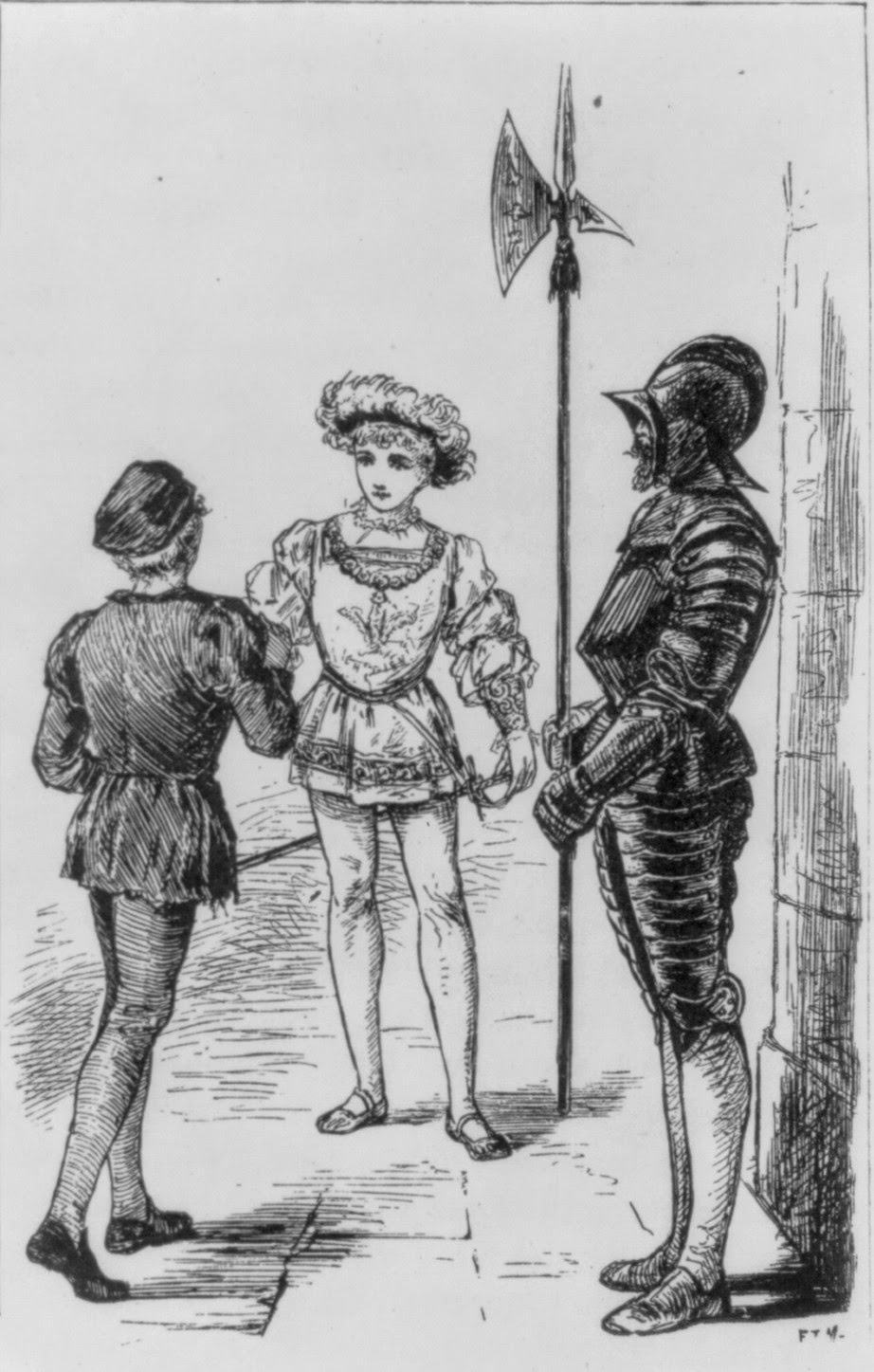 |
Edward Tudor, the prince, meets Tom Canty, the pauper and street urchin.
|
On Sunday I went to see our granddaughter in
The Prince and The Pauper, a production of the drama class at her high school, where she is in the arts program. She's also a member of the concert band . . . proud Grandma here . . . but that's a topic for a future blog.
The play was wonderful, full of energy. I'd forgotten all but the basic plot of Mark Twain's classic story of switching identities. The dialogue was at times poignant and then, very funny. Both audience and players were obviously enjoying themselves, and the young actors delivered their lines without a hitch. Granddaughter's role was a small one; she is only in her first year of the program, a "minor niner." There'll be bigger roles to come for her.
The set was perfect, and the period costumes were amazing, both street urchins and royal courtiers. In fact, the royal crown and King Henry's jewels looked quite authentic.
All in all, it was a fun production, and the cast got a well-deserved standing ovation after the final curtain. And why not? I don't go along with the theatre purists who insist that standing ovations should be reserved for the likes of the late Pavarotti or the Broadway cast of . . . (you fill in the blanks here). Do you agree?
Why do we choke up with emotion at delivering a Standing O? I think it's because we feel the love, and that audience at the school, many of whom were parents and grandparents, was bursting with pride and love for those young drama students.
Bravo! I say
 |
| Edward Tudor, the prince, meets Tom Canty, the pauper and street urchin. |
On Sunday I went to see our granddaughter in
The Prince and The Pauper, a production of the drama class at her high school, where she is in the arts program. She's also a member of the concert band . . . proud Grandma here . . . but that's a topic for a future blog.
The play was wonderful, full of energy. I'd forgotten all but the basic plot of Mark Twain's classic story of switching identities. The dialogue was at times poignant and then, very funny. Both audience and players were obviously enjoying themselves, and the young actors delivered their lines without a hitch. Granddaughter's role was a small one; she is only in her first year of the program, a "minor niner." There'll be bigger roles to come for her.
The set was perfect, and the period costumes were amazing, both street urchins and royal courtiers. In fact, the royal crown and King Henry's jewels looked quite authentic.
All in all, it was a fun production, and the cast got a well-deserved standing ovation after the final curtain. And why not? I don't go along with the theatre purists who insist that standing ovations should be reserved for the likes of the late Pavarotti or the Broadway cast of . . . (you fill in the blanks here). Do you agree?
Why do we choke up with emotion at delivering a Standing O? I think it's because we feel the love, and that audience at the school, many of whom were parents and grandparents, was bursting with pride and love for those young drama students.
Bravo! I say
View Next 25 Posts







